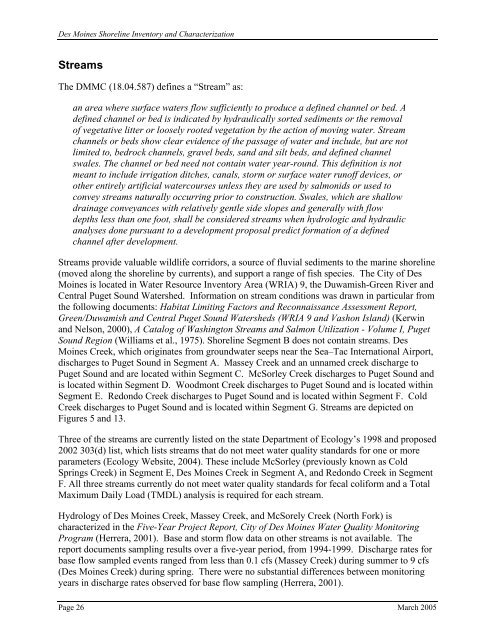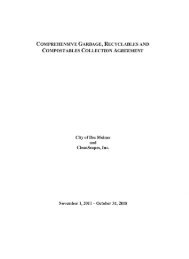CITY OF DES MOINES SHORELINE MASTER PROGRAM
CITY OF DES MOINES SHORELINE MASTER PROGRAM
CITY OF DES MOINES SHORELINE MASTER PROGRAM
Create successful ePaper yourself
Turn your PDF publications into a flip-book with our unique Google optimized e-Paper software.
Des Moines Shoreline Inventory and Characterization<br />
Streams<br />
The DMMC (18.04.587) defines a “Stream” as:<br />
an area where surface waters flow sufficiently to produce a defined channel or bed. A<br />
defined channel or bed is indicated by hydraulically sorted sediments or the removal<br />
of vegetative litter or loosely rooted vegetation by the action of moving water. Stream<br />
channels or beds show clear evidence of the passage of water and include, but are not<br />
limited to, bedrock channels, gravel beds, sand and silt beds, and defined channel<br />
swales. The channel or bed need not contain water year-round. This definition is not<br />
meant to include irrigation ditches, canals, storm or surface water runoff devices, or<br />
other entirely artificial watercourses unless they are used by salmonids or used to<br />
convey streams naturally occurring prior to construction. Swales, which are shallow<br />
drainage conveyances with relatively gentle side slopes and generally with flow<br />
depths less than one foot, shall be considered streams when hydrologic and hydraulic<br />
analyses done pursuant to a development proposal predict formation of a defined<br />
channel after development.<br />
Streams provide valuable wildlife corridors, a source of fluvial sediments to the marine shoreline<br />
(moved along the shoreline by currents), and support a range of fish species. The City of Des<br />
Moines is located in Water Resource Inventory Area (WRIA) 9, the Duwamish-Green River and<br />
Central Puget Sound Watershed. Information on stream conditions was drawn in particular from<br />
the following documents: Habitat Limiting Factors and Reconnaissance Assessment Report,<br />
Green/Duwamish and Central Puget Sound Watersheds (WRIA 9 and Vashon Island) (Kerwin<br />
and Nelson, 2000), A Catalog of Washington Streams and Salmon Utilization - Volume I, Puget<br />
Sound Region (Williams et al., 1975). Shoreline Segment B does not contain streams. Des<br />
Moines Creek, which originates from groundwater seeps near the Sea–Tac International Airport,<br />
discharges to Puget Sound in Segment A. Massey Creek and an unnamed creek discharge to<br />
Puget Sound and are located within Segment C. McSorley Creek discharges to Puget Sound and<br />
is located within Segment D. Woodmont Creek discharges to Puget Sound and is located within<br />
Segment E. Redondo Creek discharges to Puget Sound and is located within Segment F. Cold<br />
Creek discharges to Puget Sound and is located within Segment G. Streams are depicted on<br />
Figures 5 and 13.<br />
Three of the streams are currently listed on the state Department of Ecology’s 1998 and proposed<br />
2002 303(d) list, which lists streams that do not meet water quality standards for one or more<br />
parameters (Ecology Website, 2004). These include McSorley (previously known as Cold<br />
Springs Creek) in Segment E, Des Moines Creek in Segment A, and Redondo Creek in Segment<br />
F. All three streams currently do not meet water quality standards for fecal coliform and a Total<br />
Maximum Daily Load (TMDL) analysis is required for each stream.<br />
Hydrology of Des Moines Creek, Massey Creek, and McSorely Creek (North Fork) is<br />
characterized in the Five-Year Project Report, City of Des Moines Water Quality Monitoring<br />
Program (Herrera, 2001). Base and storm flow data on other streams is not available. The<br />
report documents sampling results over a five-year period, from 1994-1999. Discharge rates for<br />
base flow sampled events ranged from less than 0.1 cfs (Massey Creek) during summer to 9 cfs<br />
(Des Moines Creek) during spring. There were no substantial differences between monitoring<br />
years in discharge rates observed for base flow sampling (Herrera, 2001).<br />
Page 26 March 2005



